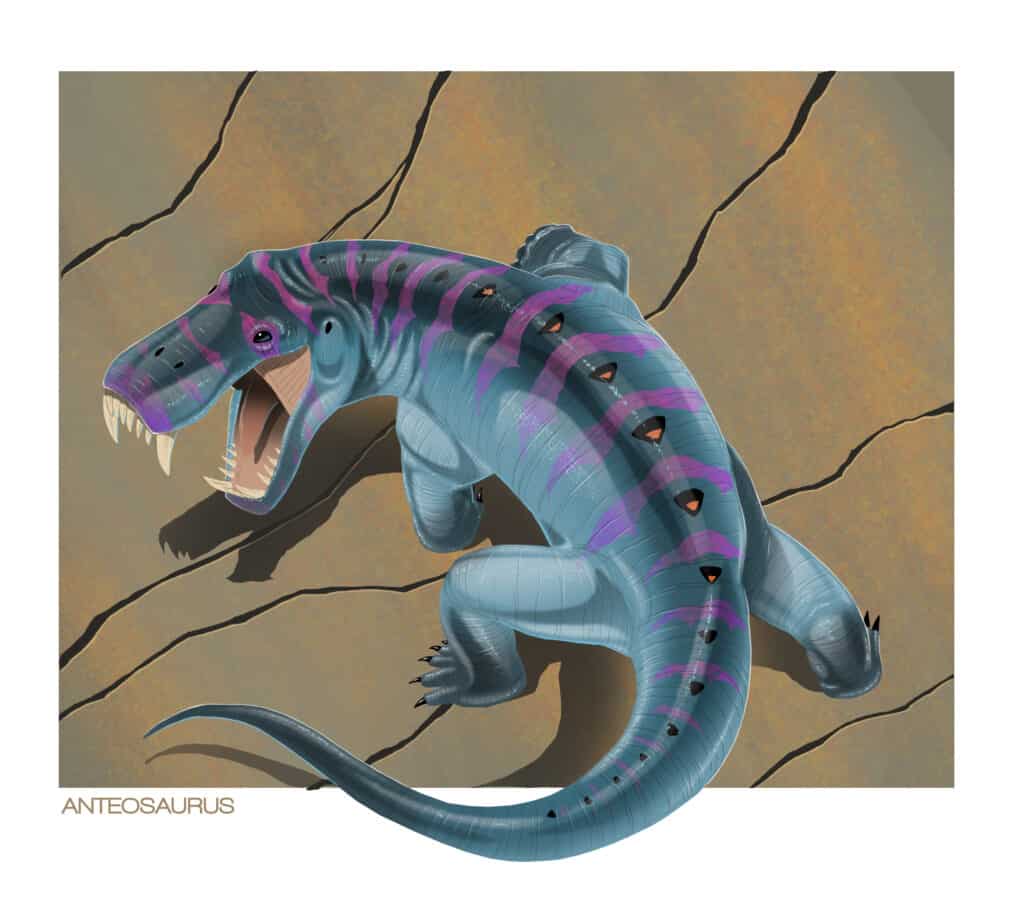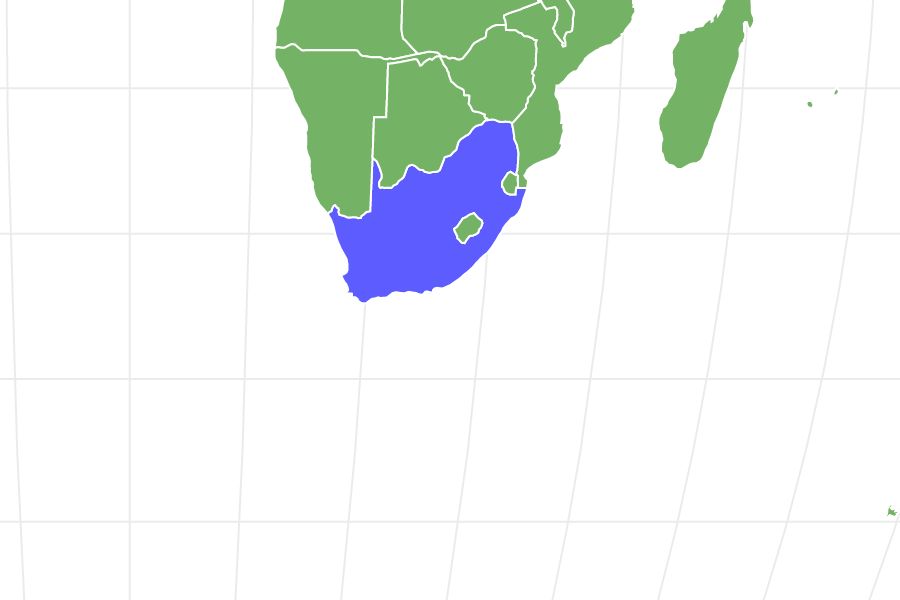Anteosaurus
Anteosaurus magnificus
Although the Anteosaurus looked like a crocodile, it is more related to mammals than reptiles.
Advertisement
Anteosaurus Scientific Classification
- Kingdom
- Animalia
- Phylum
- Chordata
- Class
- Reptilia
- Order
- Therapsida
- Family
- Anteosauridae
- Genus
- Anteosaurus
- Scientific Name
- Anteosaurus magnificus
Read our Complete Guide to Classification of Animals.
Anteosaurus Conservation Status
Anteosaurus Facts
- Fun Fact
- Although the Anteosaurus looked like a crocodile, it is more related to mammals than reptiles.
- Most Distinctive Feature
- Anteosaurus had a thick skull.
- Distinctive Feature
- They had large teeth on the roof of their mouth
View all of the Anteosaurus images!
Anteosaurus is a genus of large mammal-like reptiles that lived during the Permian Period (266-260 million years ago). The Anteosaurus lived in a region that is now in present-day South Africa. It had a semi-aquatic lifestyle similar to that of present-day crocodiles. However, the Anteosaurus is not related to crocodiles. All members of the genus died off during the middle-late Permian, and they have no living descendants.
Description & Size

Anteosaurus was a large mammal-like reptile that lived during the Permian Period in what is now South Africa.
©Timothy J. Bradley/Shutterstock.com
Anteosaurus is a genus of large carnivorous reptiles. It belongs to an ancient group of animals known as Synapsids. This is a group of animals that includes mammals and other animals that are closely related to them (such as sauropods, another group that includes reptiles and birds).
The name Anteosaurus means “early reptile.” However, it could also mean “Antaeus reptile,” a reference to a creature from Greek mythology. The Anteosaurus was probably the largest non-mammalian carnivore in the synapsid family. It weighed around 1100lb – 1300lb and was about 16-19 feet long.
Anteosaurus had a prominent skull. The narrow skull alone was about 31 inches in length. Like the crocodile, the Anteosaurus lived as a semi-aquatic animal. Thus, it had short, weak limbs and a long tail.
Among the most prominent characteristics of the members of this genus is their dentition. They had large teeth on the roof of their mouth, confined in a cluster near the outer-tooth row. Their normal dentition could be divided into anterior, canine, and cheek teeth. The anterior teeth had a ledge, a feature they share with other dinocephalians. The canine teeth were large and prominent. The cheek teeth were smaller and numbered ten in total.
Like many other therapsids, the Anteosaurus had a thick skull. Scientists believe this thickened skull was an adaptation for headbutting as a way of fighting over territory or mating behavior. Experts also think this behavior would mean they were active on land just as much as they were in the water.
Diet – What Did Anteosaurus Eat?
The Anteosaurus was mainly a carnivore. However, scientists think some members of this genus might have been herbivorous or omnivorous. Initially, paleontologists believed that the Anteosaurus and other dinocephalians were sluggish, crocodilian-like predators. This would mean it hunted by stealth and could pull land animals into the water as modern-day crocodiles do instead of taking them on land. However, based on more recent studies, scientists now think this view is inaccurate.
Despite its massive size, the Anteosaurus was most likely a fast and agile animal. It had well-developed senses, including a large inner ear. Also, the section of the brain that coordinates eye movement was large, which means this reptile would have been great at tracking prey. These findings led scientists to conclude that it was an apex predator that was capable of swift hunting and fast strikes.
Habitat – When and Where It Lived
The Anteosaurus lived during the middle-late Permian in a region that is in present-day South Africa. So far, it is the only member of the family Anteosauridae that paleontologists have discovered in the temperate zone of South Africa. However, the area would have had a different climate at the time.
Paleontologists have limited information about the specific environment where the Anteosaurus lived. However, based on a comparison with some other dinocephalians from Russia, there are indications that it might have lived in environments close to water. Also, features such as a long tail, weak limbs and the sprawling posture of the Anteosaurus have led scientists to conclude that they lived as predominantly semi-aquatic animals. However, they were quite active on land as well
Threats And Predators
Being such a large predator, it is unlikely that the Anteosaurus would have had many predators. It has a dentition that suggests that it was capable of defending itself. Scientists think members of this genus might have competed with each other for mates or territory due to their thick skull-roof.
Discoveries and Fossils – Where It was Found
The Anteosaurus lived during the Permian Period, about 30 million years before the first dinosaurs appeared. Paleontologists found the skull of a juvenile Anteosaurus in the Eastern Cape Province of South Africa in 1921. Although they have discovered many dinocephalian skull fragments in South Africa prior to that time (and many more in Russia), the Anteosaurus magnificus is the only species of this genus found to date. It is also the only member of the Anteosauridae family in the South African temperate zone.
Extinction – When Did It Die Out?
The Anteosaurus, along with other synapsids, were among the most dominant groups of animals on the planet during the middle to late Permian period. They flourished for millions of years. However, they were most likely wiped out by the Permian–Triassic mass extinction about 250 million years ago. The Anteosaurus has no living descendants.
Similar Animals to the Anteosaurus
Similar animals to the Anteosaurus include:
- Titanognathus: The Titanognathus is an extinct genus of non-mammalian therapsid that lived during the Permian.
- Tapinocaninus: This is an extinct genus of therapsids that belonged to the family Tapinocephalidae. Paleontologists consider them to be the ancestors of the Anteosaurus.
- Titanophoneus: also known as the “titanic murderer,” the Titanophoneus is an extinct genus of carnivorous that lived around the same time as the Anteosaurus but in a different territory.
Related Animals
View all 194 animals that start with AAnteosaurus FAQs (Frequently Asked Questions)
When was the Anteosaurus alive?
Anteosaurus lived about 266-260 million years ago. This was during the Permian period.
How big was Anteosaurus?
The anteosaurus was a large reptile about 16 feet in length. The skull of this lizard alone was about 32 inches, and it might have weighed about 1100-1300 lbs.
Was the Anteosaurus a dinosaur?
No. Despite its fierce dinosaur-like appearance, the anteosaurus was not a dinosaur. It belongs to a group of mammal-like reptiles that roamed the planet before the dinosaurs. They were called dinocephalians. The last of the dinocephalians died about 30 million years before the dinosaurs.
Thank you for reading! Have some feedback for us? Contact the AZ Animals editorial team.
Sources
- Prehistoric Wildlife, Available here: http://www.prehistoric-wildlife.com/species/a/anteosaurus.html
- Eureka Alerty/UNIVERSITY OF THE WITWATERSRAND, Available here: https://www.eurekalert.org/news-releases/918007
- Local News Matters: Bay Area/Julien Benoit, Available here: https://localnewsmatters.org/2021/04/05/meet-anteosaurus-new-study-reveals-the-secrets-of-an-ancient-extinct-super-predator/
- Wikipedia, Available here: https://en.wikipedia.org/wiki/Anteosaurus

















